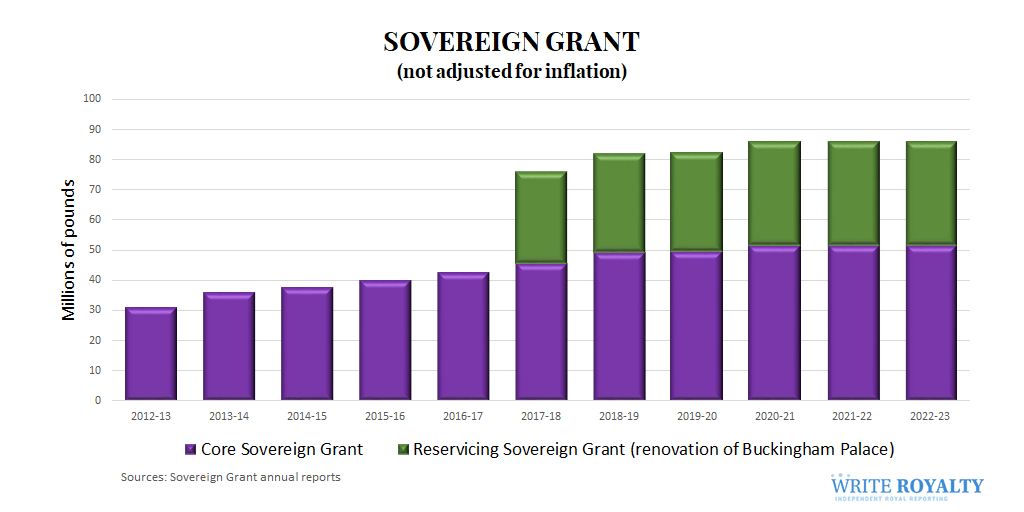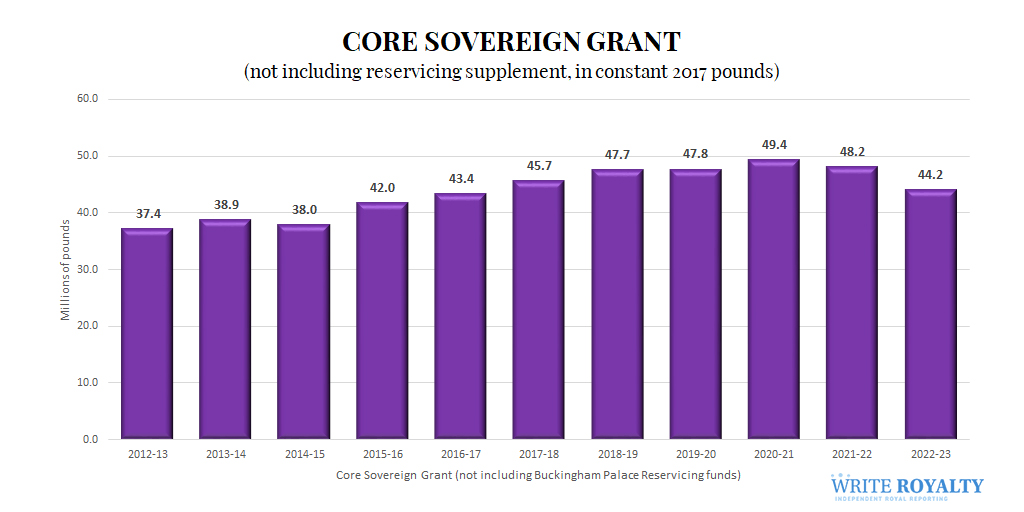Red ink and fewer public engagements
Bad news from the Sovereign Grant annual report and half-year royal work stats
It’s July 4, and this is my data dive into royal finances and workloads
FIRST, THE SOVEREIGN GRANT


The style of most current Sovereign Grant report is identical to those in past years. Even the maroon shade of the background is the same. But the image indicates the most fundamental of changes — the throne has passed from Queen Elizabeth II to her son, King Charles III and his wife, Queen Camilla.
“A year of grief, change and celebration, the like of which our nation has not witnessed for seven decades,” explained Sir Michael Stevens, Keeper of the Privy Purse (don’t let his archaic title fool you, he’s in charge of the financial management of the royal household).
As with previous years, the 132-page report and media briefing generated headlines:
Prince Harry and Meghan, Duchess of Sussex, have officially vacated Frogmore Cottage after the King didn’t renew their lease
The gender pay gap among royal staff was reduced from 8.6% to 5.7%, compared to a national average of almost 50%; and there’s gender parity in the overall headcount
The proportion of ethnic minority employees is 9.7%, the same as the previous year, and well below the 2025 target of 14% though ethnic minorities hold12.2% of senior roles
Along with the inevitable stories, King Charles III inherits a royal budget dripping in red ink, as palace finances have been battered by the pandemic, inflation, and surges in energy costs.
I’ve been analyzing Sovereign Grant reports since they were first published. This was a no good, very bad year.
THE BACKGROUND
The Sovereign Grant Act of 2011 is designed to fund the official duties of the monarch and maintain the occupied royal palaces. (Side note: unoccupied residences, such as Hampton Court Palace, are maintained by the non-profit Historic Royal Palaces; the Prince of Wales funds his family through the ancient Duchy of Cornwall; and the monarch supports the rest of the working royals through the Duchy of Lancaster.) The Sovereign Grant was fixed at 15% of the profits of the Crown Estate, which are held “in right of the Crown.” In 2017, that profit share was increased to 25% as a temporary 10% was added to finance the “Reservicing of Buckingham Palace,” as they call the extensive renovations needed throughout the historic building, including replacing wiring and other utilities that date back to before the late Queen’s reign.
It’s a good deal for the government as it gets 75% of the Crown Estate’s profits. But the deal expires upon the death of the sovereign. So this year’s report for the 2022-23 financial year begins with this subtle reminder that the Crown Estate ultimately belongs to the Crown, not the government:
The official expenditure of the Sovereign is met from public funds in exchange for the surrender by The Sovereign of the revenue from the Crown Estate. His Majesty King Charles III, following His Majesty’s Accession on 8 September 2022, confirmed his willingness and intention to continue this tradition.
While the Sovereign Grant can grow as the Crown Estate’s profits increase, it can’t decrease. And while last year was a good year for the Crown Estate as it signed agreements for offshore windfarms (it owns the seabed), the King had asked in January that the share of those profits that would be expected to flow into the Sovereign Grant be instead used for “the wider public good.”
WHAT HAPPENED
In 2022-23, the Sovereign Grant was frozen at the previous year’s level: 51.8 million pounds for the “core” Sovereign Grant and another 34.5 million for the “reservicing,” bringing the total to 86.3 million, which works out to 1.29 pounds or CAD$2.20 per person. It wasn’t enough.
When one ignores the reservicing amount — as it can only be used for the renovation — the so-called Core Sovereign Grant has increased by only 5% in the past five years.
As well, inflation is also eating into the value of that Core Sovereign Grant. If constant 2017 pounds are used, then royal accountants received the equivalent of 44.2 million pounds in 2022-23, a level of funding not seen since before 2017-18.
This year, costs increased almost across the board. Some fiscal problems were shared by people around the world including inflation, which contributed to a 14-percent increase in payroll costs. As well, spiking energy prices following the Russian invasion of Ukraine meant that natural gas costs tripled even though staff cut consumption by 18%. In addition, the slow return of tourists hit the royal income streams as revenues are down about 50% since before the pandemic.
Other expenses were very royal: the return of garden parties and other big events caused housekeeping and hospitality costs to surge by 85%. As well, the Platinum Jubilee and death of Queen Elizabeth II were costly, as was answering a record 180,000 pieces of mail and 50,000 applications for birthday cards.
As Sir Michael Stevens explained:
That has inevitably entailed additional burdens on resources to ensure that these historic events were delivered safely and smoothly, and that the change of reign was effected as seamlessly as possible at a time of great national and international interest.
The end result: the royal household spent 21.2 million pounds more than it brought it. It balanced the books by dipping into reserves saved from better times.
WHAT TO DO
Well, everyone is going to be wearing sweaters this winter. Temperatures are being reduced to 19C for occupied rooms and 16C for empty ones. Even the water in the swimming pool at Buckingham Palace, which is used by staff as well as royals, is now set to a brisk temperature. They are also deferring some maintenance and looking for efficiencies (likely through a reduction in staff after the merger of the late Queen’s household with that of the new monarch beyond the 16 already confirmed).
They are also pressing ahead with the reservicing as its modernizations of outdated infrastructure will help bring down energy costs. As well, tourism is returning to pre-pandemic levels, which will bring in much-needed income.
Ultimately, the royal accountants will have to figure out how to balance the books. After all, there’s only 10.1 million pounds left in that Sovereign Grant Reserve.
WHAT’S NEXT
Well, the balance sheet may get worse before it gets better. And that can be seen in another of my Excel spreadsheets.
Keep reading with a 7-day free trial
Subscribe to WRITE ROYALTY by Patricia Treble to keep reading this post and get 7 days of free access to the full post archives.






